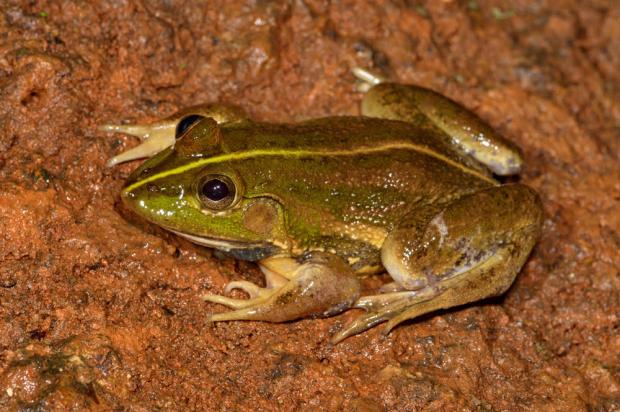
Karaavali Skittering Frog, Photo: KS Seshadri / Research Matters
The frog was first chanced upon by a citizen scientist thinking it was a bird call.
A team of frog enthusiasts including citizens, freelance researchers and scientists have discovered a new species of skittering frog (Euphlyctis karaavali) from coastal plains of Karnataka, India. This frog, measuring up to 11 cm in length and was first recorded in 2015 from a sleepy coastal village named Sanikatta in Kumta Taluk, Karnataka.
This frog is named Euphlyctis karaavali after Karaavali, the coastal region of Karnataka. The Karaavali skittering frog is considered to be endangered due to its restricted geographic area. The frog belongs to a group known as “skittering frogs”, because of their habit of floating on water and skittering away when disturbed. Currently there are only seven known species in this genus and are found as far west as the Southwestern Arabian Peninsula through South East Asia to the east.
During a routine field work, researchers from Gubbi Labs made a courtesy call to Mr. CR Naik of Sanikatta, Kumta Taluka, Karnataka. On this occasion, Mr. CR Naik played a call on his mobile phone and claimed that he recorded it recently from fallow paddy fields. The call resembled very much of a white-throated king fisher bird (Halcyon smyrnensis), but CR Naik insisted that it is from a frog. Intrigued by this, Mr. Seshadri K S, a research scholar from the National University of Singapore, who is currently working on frogs of the Western Ghats visited Sanikatta to observe the frog. Naik took him to the place at night and within a few hours, they discovered this frog.
“We are well aware of Mr. CR Naik’s pranks and quick wit and were certain that the call was of a bird and he was taking us for a ride; however, Mr. Naik was adamant about the call. We conceded that the call ought to be explored more and asked Naik to make a video next time he heard it. He immediately got to work and sent us short video clips and said this was a new species of frog” says Dr. Gururaja KV, a renowned frog researcher who is an adjunct scientist at Gubbi Labs and currently a faculty member at Srishti Institute of Art, Design and Technology, Bengaluru. Gururaja has been vocal about engaging citizens in scientific pursuits and he performed the bioacoustic analysis of the call which ascertained the frog species to be indeed new to science.
Mr. CR Naik, “I am so happy that a new frog is discovered from my native place and I am doubly delighted to be part of this discovery. I am thankful for the entire team of scientists who trusted me. This discovery has motivated me and I will continue making observations, not only about frogs but in other natural history observations. Only such observations can help in creating awareness among citizens about nature” said a very elated Mr. Naik, who co-authored this discovery, is currently the Deputy Range Forest Officer at Dandeli Anshi Tiger Reserve (Kali Tiger Reserve). He is also the recipient of the prestigious Jumbo Award in honor of his nature education activities.
Priti H, a PhD student at the Ashoka Trust for Research in Ecology and the Environment (ATREE), the lead author of the paper carried out molecular analysis and confirmed the species to be new. Mr. Seshadri KS, made call records and analysis of which proved again that the species is new to science. “Indeed the frog call resembled that of a white-throated kingfisher. It was through this clue we located the frogs in inundated paddy fields and were surprised to see that the sound was indeed coming from frogs and not kingfisher bird” he said.
“Often, such scientific discoveries happen because there are foot soldiers like Mr. Naik working hard in the field. Him being a forest official and making observations on nature makes this discovery special. We hope this discovery will inspire the staff of the forest departments and research is encouraged. By joining hands with researchers, Naik has come to the forefront of biodiversity conservation. Such efforts will bring only biological research in India on par with that of the world.” said Seshadri.
The authors highlight that the frog is found along the coastal plains of Karnataka in Uttara Kannada, Udupi and Dakshina Kannada districts. The new species is however already under threat from expanding developmental activities like expansion of highways and conversion of land to non agricultural purposes. The team comprised of Priti H, Naik CR, Seshadri KS, Ramit Singal, Vidisha MK, Ravikanth G and and Gururaja KV. The paper appeared in the 25th December 2016 issue of Asian Herpetological Research.
